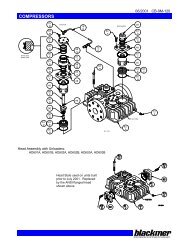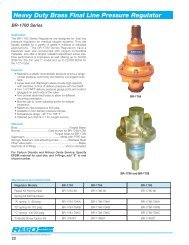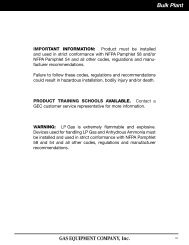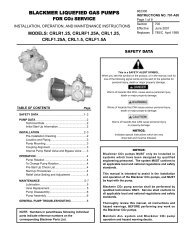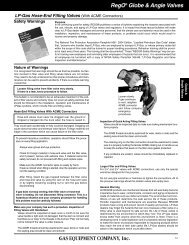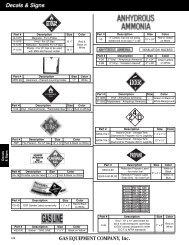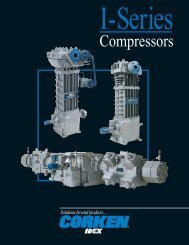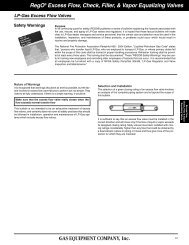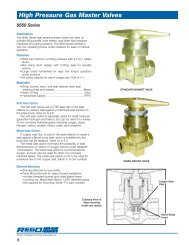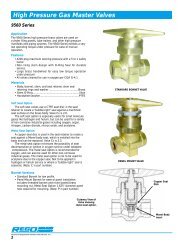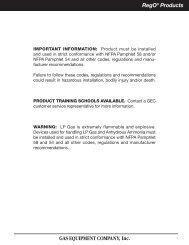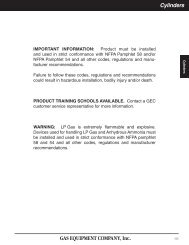RegO® Cylinder & Service Valves - Gas Equipment Company, Inc.
RegO® Cylinder & Service Valves - Gas Equipment Company, Inc.
RegO® Cylinder & Service Valves - Gas Equipment Company, Inc.
Create successful ePaper yourself
Turn your PDF publications into a flip-book with our unique Google optimized e-Paper software.
RegO ® Pressure Relief <strong>Valves</strong> & Relief Valve Manifolds<br />
ECII ® Safety Warning — LP-<strong>Gas</strong> Pressure Relief <strong>Valves</strong><br />
Purpose<br />
In its continuing quest for safety, Engineered Controls International,<br />
<strong>Inc</strong>. is publishing safety warning bulletins explaining the hazards associated<br />
with the use, misuse and aging of ECII ® / RegO ® Products. LP-<br />
<strong>Gas</strong> dealer managers and service personnel must realize that the failure<br />
to exercise the utmost care and attention in the installation, inspection<br />
and maintenance of these products can result in personal injury<br />
and property damage.<br />
The National Fire Protection Association Pamphlet #58 “Storage and<br />
Handling of Liquefied Petroleum <strong>Gas</strong>es” states: “In the interests of<br />
safety, all persons employed in handling LP-<strong>Gas</strong>es shall be trained in<br />
proper handling and operating procedures.” ECII ® Warning Bulletins<br />
are useful in training new employees and reminding older employees<br />
of potential hazards.<br />
This Warning Bulletin should be provided to all purchasers of ECII ® /<br />
RegO ® Products and all personnel using or servicing these products.<br />
Additional copies are available from Engineered Controls International,<br />
<strong>Inc</strong>. and your Authorized ECII ® / RegO ® Products Distributor.<br />
What You Must Do:<br />
• Read This Entire Warning<br />
• Install Properly<br />
• Inspect Regularly<br />
• Replace In 10 Years or Less<br />
Scope<br />
This bulletin applies to pressure relief valves installed on stationary,<br />
portable and cargo containers and piping systems utilized with these<br />
containers. This bulletin is not intended to be an exhaustive treatment<br />
of this subject and does not cover all safety practices that should be<br />
followed in the installation and maintenance of LP-<strong>Gas</strong> systems. Each<br />
LP-<strong>Gas</strong> employee should be provided with a copy of NPGA Safety<br />
Pamphlet 306 “LP-<strong>Gas</strong> Regulator and Valve Inspection and<br />
Maintenance” as well as the NPGA “LP-<strong>Gas</strong> Training Guidebooks”<br />
relating to this subject.<br />
Warnings should be as brief as possible. If there is a simple warning, it is:<br />
Inspect pressure relief valves regularly. Replace unsafe or suspect<br />
valves immediately. Use common sense.<br />
Install Properly<br />
Consult NFPA Pamphlet #58 and/or any applicable regulations<br />
governing the application and use of pressure relief<br />
valves. Make sure you are thoroughly trained before you<br />
attempt any valve installation, inspection or maintenance.<br />
Pipeaways and deflectors may be required by local codes, laws<br />
and regulations depending on the installation. Use only ECII ® /<br />
RegO ® adapters on ECII ® / RegO ® relief valves. Adapters not<br />
designed specifically for piping away ECII ® / RegO ® relief valves, such<br />
as those with 90° turns or reduced internal diameters, will decrease<br />
flow dramatically. These should never be used as they can cause the<br />
relief valve to chatter and eventually destroy itself.<br />
Proper installation is essential to the safe operation of pressure relief<br />
valves. When installing ECII ® / RegO ® pressure relief valves, consult<br />
warning # 8545-500 which accompanies each valve. Check for damage<br />
and proper operation after valve installation. Check that the valve<br />
is clean and free of foreign material.<br />
The addition of deflectors, pipeaway adapters and piping will<br />
restrict the flow. To properly protect any container, the total<br />
system flow must be sufficient to relieve pressure at the pressure<br />
setting of the relief valve in accordance with all applicable<br />
codes.<br />
Inspect Regularly<br />
A pressure relief valve discharges when some extraordinary circumstance<br />
causes an over pressure condition in the container. If a<br />
pressure relief valve is known to have discharged, the relief valve,<br />
as well as the entire system, should be immediately and thoroughly<br />
inspected to determine the reason for the discharge. In the<br />
case of discharge due to fire, the valve should be removed from<br />
service and replaced.<br />
Relief valves should be inspected each time the container is<br />
filled but no less than once a year. If there is any doubt about<br />
the condition of the valve, it must be replaced.<br />
Eye protection must be worn when performing inspection on relief<br />
valves under pressure. Never look directly into a relief valve under pressure<br />
or place any part of your body where the relief valve discharge<br />
could impact it. In some cases a flashlight and a small mirror are suggested<br />
to assist when making visual inspections.<br />
38



